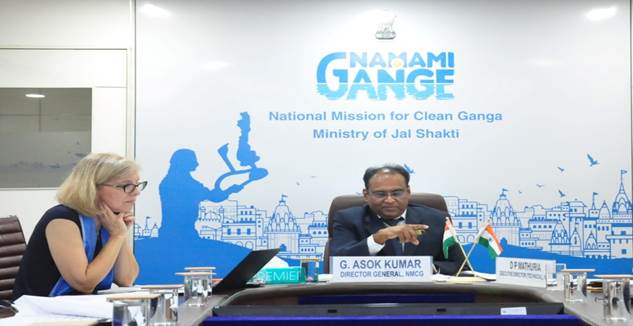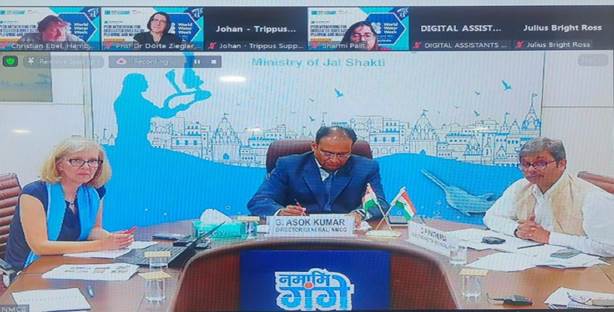Stockholm Water Week 2023: DG, NMCG Chairs Session On ‘Peer Networking for Integrated River Basin Planning and Management’
The Director General, National Mission for Clean Ganga (NMCG) chaired an online session in Stockholm Water Week today on the theme ‘Peer Networking for Integrated River Basin Planning and Management’ with an interactive discussion on the adoption of the river basin management approach. Delivering the keynote address, DG, NMCG, Shri G. Asok Kumar said that Namami Gange is premised on the five important pillars of – Nirmal Ganga (unpolluted river), Aviral Ganga (unrestricted flow), Jan Ganga (People’s Participation), Gyan Ganga (knowledge and research based interventions) and Arth Ganga (people-river connect through the bridge of economy). He informed that Namami Gange is among the world’s acclaimed river rejuvenation programs and was recognized as one of the top 10 “World Restoration Flagships” on December 13th, 2022, during UN Conference on Biological Diversity (COP 15) in Montreal.

DG, NMCG said that Namami Gange Mission involves a substantial financial commitment of USD 4.5 billion and the interventions have already made positive impact as evidenced from restoration of polluted stretches of the river and significant improvement in river water quality. He noted that there has been a noticeable surge in sightings of aquatic species such as Gangetic Dolphins, Gharials and Turtles. More than 9.3 million Indian Major Carps (Katla, Rohu, and Mrigal) and 90,000 Hilsa fish have been ranched in the Ganga Basin. In addition, capacity development programs for forest officials have also been initiated to strengthen conservation efforts.
Shri Kumar gave an overview of the five-tiered governance structure of NMCG with the National Ganga Council headed by the Prime Minister at the top and District Ganga Committees at the district-level. He also spoke about Arth Ganga heralding economic growth, livelihood advancement, and community engagement in the river basin. Through Arth Ganga, he said, NMCG aims to establish resilient institutions to guide and harness sustainable development endeavors via institutional building, zero-budget natural farming, formation of FBOs, public participation, monetization of wastewater and sludge, cultural heritage, tourism, and livelihood generation. He emphasized the role of District Ganga Committees (DGCs) in effective execution of Arth Ganga interventions. “We have revitalized the DGCs and launched DGC 4M (Monthly, Mandated, Monitored and Minuted). This has resulted in routine meetings of DGCs discussing crucial issues at hand,” he said, adding, “Between April 2022 to July 2023, a total of 1689 meetings have been conducted.”

DG, NMCG informed the participants that to foster awareness and youth engagement through a network of universities, a MoU signing ceremony – Namami Gange: Universities Connect – was organised in April 2023. This was preceded by a year-long webinar series with universities – ‘Igniting Young Minds, Rejuvenating Rivers’. “A dynamic shift from engineering to public participation is being made for comprehensive solutions,” he added.
The River-Cities Alliance, DG, NMCG said, is another novel initiative providing a dedicated platform for Indian river cities to ideate, deliberate, and share insights for sustainable urban river management. NMCG is harnessing expertise from entities such as GIZ. He noted that steps are being taken to strengthen institutions, with a strategic focus on setting up a River Basin Management Unit. “By engaging international experts, NMCG is poised to ensure well-grounded plans and effective guidance. The collaborative framework will facilitate development of a river rejuvenation model which can be emulated to rivers worldwide,” he added.
The Head of Programme, Support to Ganga Rejuvenation/India EU Partnership GIZ India, Ms. Martina Burkard highlighted the need for more collaborative efforts in river basin management. She noted that the trajectory of Ganga basin governance has evolved through distinct phases, from development of comprehensive Ganga basin management plans to implementation-oriented sub-basin plans. “These sub-basin plans are aligned with district-level and overarching river basin management strategies,” she said, adding, “NMCG adopts a dynamic approach, drawing on international experience.” The engagement of stakeholders forms the bedrock of this approach, facilitating a cyclical progression, she said, adding, central to this approach is bringing districts to the forefront. She added that an intricate framework has been developed, fostering collaboration between districts and NMCG to delineate the blueprint of District Ganga Plans. She concluded her address by highlighting how peer networking stands as a powerful tool, uniting stakeholders from diverse domains.
Faculty, Water Resources and Environmental Management, University of Applied Sciences, Koblenz, Prof. Dorte Ziegler talked about the importance of transboundary cooperation and how it has emerged as a pivotal theme in addressing water-related challenges. She emphasized the universality of water, unconfined by boundaries, as river basins transcend geopolitical demarcations. The interconnectedness of upstream and downstream nations underscores the shared responsibility in safeguarding water resources. Prof. Ziegler spotlighted the profound impact on fish migration, using the instance of the Ryan River, which sustains numerous cities with essential drinking water. As cities grapple with multifaceted issues like water treatment and infrastructure, collaborative problem-solving approach becomes imperative, she said. adding, NMCG’s ongoing endeavors in embracing an integrated strategy recognizing it as an effective path forward is laudable.
Senior Advisor, Department of Water Management, Hamburg City, Ministry for Environment, Climate, Energy and Agriculture, Germany, Mr. Christian Ebel highlighted the complexity of water laws within different provinces of the country and the unique challenge posed as water does not adhere to the jurisdictional boundaries. He elaborated on the concept of River Basin Management Committees, where states collectively participate to ensure the effective implementation, coordination, and assessment of river basin management measures. He added that a paramount aspect of river basin management is fostering synergy through active public participation and involving stakeholders from diverse domains. Collaboration with experts is essential to enrich the decision-making process and ensure a holistic understanding of the river ecosystem.
Lead Water Specialist, World Bank, Ms. Carmen Rosa Yee Batista emphasized the need for collaborative efforts to scale up river activities. She outlined three critical practices for successful river rejuvenation programs- strengthening knowledge-based approaches, effective data communication and monitoring, and strengthening governmental structures. She also highlighted the significance of involving local stakeholders, facilitating shared decision-making processes, and addressing the expectations of diverse groups.
Ms. Sharmi Palit from National University of Singapore shed light on the importance of self-motivated cadres like Ganga Praharis that exemplifies local communities continuing to uphold the goals of missions like Namami Gange even after the program’s exit from the field.
Shri D.P. Mathuria (ED-NMCG) moderated the session and Ms. Martina Burkard (Head of Programme, Support to Ganga Rejuvenation/India EU Partnership GIZ India) gave the Vote of Thanks. More than 160 people participated in the session. On 20th August, DG, NMCG also took part in a session on ‘Water Quality Management: Lessons learned from India’ on the opening day of the Stockholm Water Week.

